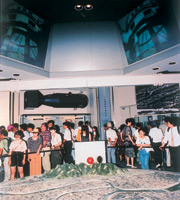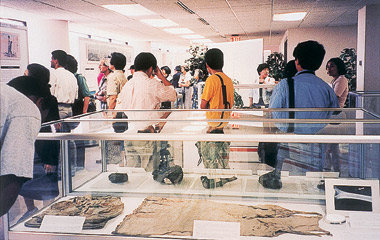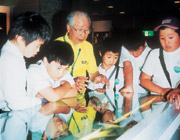1991- Conveying the Spirit of Hiroshima to the World
|
Fifty years after the atomic bombing, the hibakusha were aging conspicuously and their experience was slipping rapidly from human memory. Concrete efforts to ensure the transmission of the experience to future generations included a campaign to register the A-bomb Dome as a World Heritage site and projects to preserve A-bombed buildings.
In 1991, the Peace Memorial Museum reopened after a second major renovation. In 1989, the City Auditorium was remodeled, becoming the International Conference Center Hiroshima, and in 1994, Peace Memorial Hall reopened as the museum's East Building.
The older of the two connected buildings continued to convey the A-bomb experience, while the new one offers space for peace studies. The Peace Memorial Museum today features greatly expanded display space and other functions.
In 1995 the people of Hiroshima were shocked by cancellation of a long-planned A-bomb exhibition at the U.S. Smithsonian Institution's National Air and Space Museum. This incident spurred efforts to display the museum's artifacts in A-bomb exhibitions overseas.
A-bomb artifacts are now important tools for communicating atomic bomb damage and Hiroshima's tragedy throughout the world.
|
 |
 |
 |
 |
 |

28*Second major renovation
August 1, 1991 Hiroshima Peace Memorial Museum
Courtesy of Chugoku Shimbun
In 1991, the present museum opened after a complete renovation. To make the bombing more visually comprehensible to young visitors, the new displays included a model of Little Boy and large images. The wax figures in the exhibit depicting the time of the bombing were made more realistic. Visitors frequently said, "This is better, easier to understand." Still, many survivors voiced criticisms: "The bombing was much worse than this makes it look."

31*Guestbooks from A-bomb exhibition at American University
Cancellation of the A-bomb Exhibition planned by the Smithsonian Institution's National Air and Space Museum revealed the wide chasm separating the views of many Americans from those of many Japanese over the 50 years since the war's end. A wide variety of views both supporting and opposing the atomic bombing were recorded in the guestbook. This case used at the American University exhibition is taller than Japanese exhibition cases because Americans are generally taller than Japanese.
|
|

29*
The new East Building
October 2, 1998
Photo by Michio Ide
With the renewal of the Peace Memorial Hall in 1994, a new East Building with its own set of galleries became an integral part of the Peace Memorial Museum. Staff increased from 7 to 16, a climate-controlled repository was added, and exhibit space was increased dramatically. With this addition, all three of the major buildings within Peace Memorial Park were thoroughly renovated, including the International Conference Center Hiroshima completed earlier.

30*A-bomb exhibition at American University
July 1995 Washington, D.C. American University
In 1995, looking toward the 50th anniversary of the end of WWII, the National Air and Space Museum of the Smithsonian Institution in the US planned a special exhibition about the dropping of the atomic bomb. It was agreed that a number of actual artifacts would be transferred on loan from the museum. However, fierce protests by US veterans and others forced cancellation of the A-bomb exhibition. American University in Washington, D.C. responded by holding its own A-bomb exhibition.
|

32*Communicating the A-bomb experience to future generations
June 9, 2005
Hiroshima Peace Memorial Museum
Beginning in 1999, Peace Volunteers were trained to explain the displays in the museum and guide visitors through Peace Park. At this time, the oldest volunteer is 78 and the youngest 21. The total number of volunteers, who range from A-bomb survivors to young people with no experience of the atomic bombing, is now 168. Wearing a uniform green jumper, they strive to effectively communicate the A-bomb experience. (All figures are as of April 1, 2005.)
|
|

33*Toward a new museum
February 17, 2005
Hiroshima Peace Memorial Museum
Fifty years after it opened, the museum building that has grown with the people since the war is deteriorating conspicuously. The aging of the survivors has turned the question of how to communicate the A-bomb experience to future generations into a critical issue. At present, a committee of experts is studying the building and ways of renewing the exhibits. This photo was taken at the third meeting of the Exploratory Committee for Renewal Plan of Hiroshima Peace Memorial Museum, which was held in February this year.
|
|






